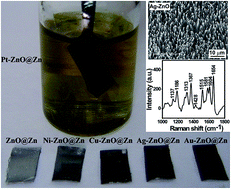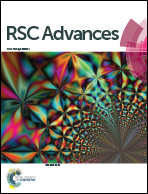A general and rapid approach to hybrid metal nanoparticle–ZnO nanowire arrays and their use as active substrates for surface-enhanced Raman scattering detection†
Abstract
We report a general and facile approach for the preparation of metal nanoparticle (such as Cu, Ag, Au, Pt and Ni)–ZnO hybrid nanowire arrays by taking advantage of a spontaneous redox reaction between the ZnO–Zn substrates and corresponding metal precursors in aqueous solution. The size and density of the metal nanoparticles grown on the ZnO nanowire can be rationally controlled by adjusting the reaction time. Interestingly, the plasmonic nanoparticles render the prepared ZnO-based hybrid nanoarrays with the ability to enhance surface-Raman scattering signals of a diverse array of molecules, including Rh 6G, 4-mercaptobenzoic acid and 4-nitrothiophenol. Moreover, a mesoporous arrangement of Ag nanoparticles with clean surfaces enables both high sensitivity and extraordinary reproducibility in the surface-enhanced Raman scattering (SERS) detection. The outstanding performance of the hybrid ZnO NW arrays in the SERS application, combined with the benefit of their fast preparation (<30 s), makes them particularly useful in rapid SERS detection of bioactive molecules for potential clinical diagnosis.


 Please wait while we load your content...
Please wait while we load your content...